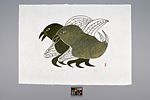Kigavik
About this object
History of use
Contemporary Inuit prints were first produced at Cape Dorset in 1957. Although precursors to printmaking can be seen in women's skin applique work and in men's incising of ivory, stone and bone, the impetus for printmaking was as a commercial venture. This venture was established jointly by Inuit artists and John Houston, the civil administrator for Cape Dorset. Other Inuit communities quickly followed the commercial success of Cape Dorset's West Baffin Eskimo Cooperative. Printmaking developed as a communal activity following a Japanese, rather than a Western, model of serigraph production. Each year the cooperatives produce a series of limited edition prints which are sold in the retail art market. In 1965, the Canadian Eskimo Arts Council was established from the Canadian Eskimo Art Committee to ensure high standards were maintained. Printmaking, along with stone carving, provide cash income for communities which have undergone rapid and significant change, during the late 20th century, from traditional hunting based societies to settled communities dependent on consumer goods. The prevalent images depicted in Inuit art are of traditional life, arctic animals and mythology. Recently, contemporary subjects have been depicted by a minority of artists.
Cultural context
contemporary art
Physical description
Print depicting two birds in profile: the front most bird has a black and yellow-black body with a v-shaped white pattern overall, and the bird at the back has a solid black body. Both birds have one black foot each and wings with linear patterns. Below the image is written, "Kigavik Stone Cut 3/50 Dorset 1974 Pitaloosee." The names of the artist and printmaker are stamped in Inuit syllabics along with the Cape Dorset Co-operative seal of the red stylized igloo to the right-hand side of the image. The Canadian Eskimo Arts Council's blind embossed seal is in the bottom right-hand corner.
Categories
